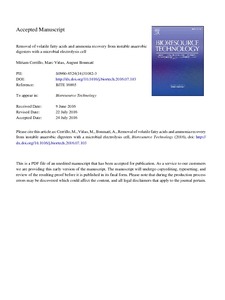Removal of volatile fatty acids and ammonia recovery from unstable anaerobic digesters with a microbial electrolysis cell

Visualitza/Obre
10.1016/j.biortech.2016.07.103
Inclou dades d'ús des de 2022
Cita com:
hdl:2117/116496
Tipus de documentArticle
Data publicació2016-11-01
Condicions d'accésAccés obert
Tots els drets reservats. Aquesta obra està protegida pels drets de propietat intel·lectual i
industrial corresponents. Sense perjudici de les exempcions legals existents, queda prohibida la seva
reproducció, distribució, comunicació pública o transformació sense l'autorització del titular dels drets
Abstract
Continuous assays with a microbial electrolysis cell (MEC) fed with digested pig slurry were performed to evaluate its stability and robustness to malfunction periods of an anaerobic digestion (AD) reactor and its feasibility as a strategy to recover ammonia. When performing punctual pulses of volatile fatty acids (VFA) in the anode compartment of the MEC, simulating a malfunction of the AD process, an increase in the current density was produced (up to 14 times, reaching values of 3500 mA m-2) as a result of the added chemical oxygen demand (COD), especially when acetate was used. Furthermore, ammonium diffusion from the anode to the cathode compartment was enhanced and the removal efficiency achieved up to 60% during daily basis VFA pulses. An AD-MEC combined system has proven to be a robust and stable configuration to obtain a high quality effluent, with a lower organic and ammonium content
CitacióCerrillo, M., Viñas , M., Bonmatí, A. Removal of volatile fatty acids and ammonia recovery from unstable anaerobic digesters with a microbial electrolysis cell. "Bioresource technology", 1 Novembre 2016, vol. 219, p. 348-356.
ISSN0960-8524
Versió de l'editorhttp://www.sciencedirect.com/science/article/pii/S0960852416310823
| Fitxers | Descripció | Mida | Format | Visualitza |
|---|---|---|---|---|
| 1-s2.0-S0960852416310823-main-sense format.pdf | 964,5Kb | Visualitza/Obre |

